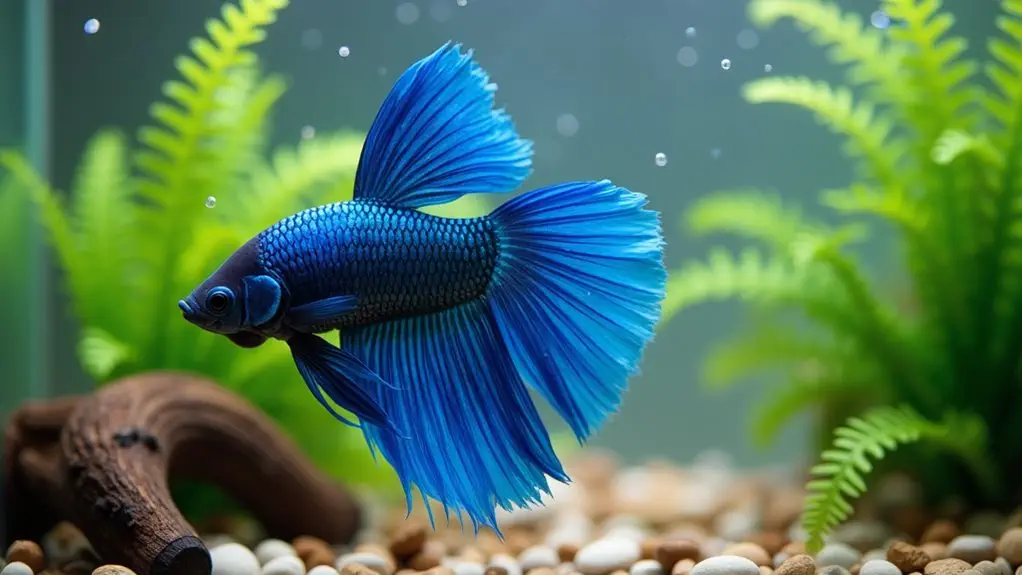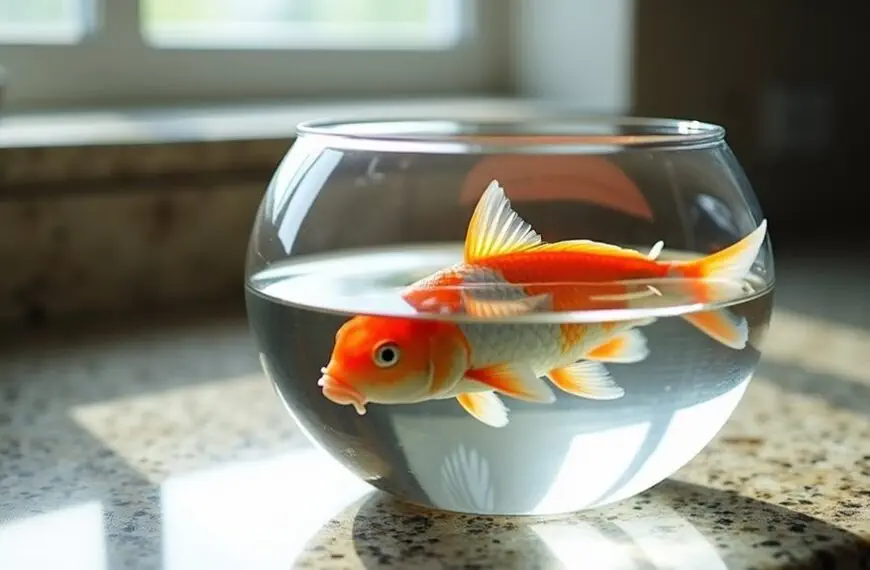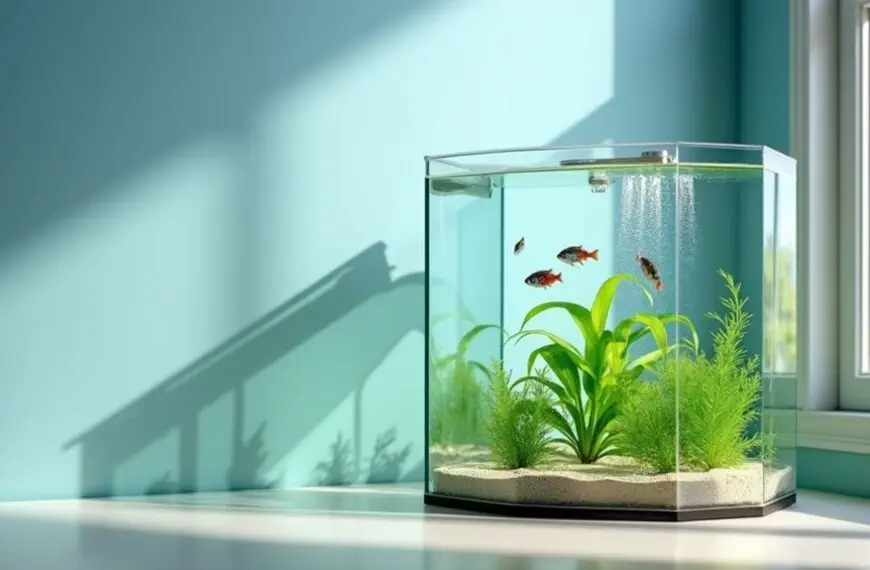If you're looking for the simplest fish to keep, you can't go wrong with a Betta fish. These gorgeous swimmers don't need a huge tank – they'll thrive in a small, well-maintained space with basic equipment like a heater and filter. You'll want to keep the water temperature between 74-82°F and perform weekly water changes of about 15-20%. Bettas are hardy, adaptable, and full of personality, making them perfect first-time pets. While they're not social butterflies with other fish, they'll interact with you and show off their stunning fins. There's much more to discover about these fascinating underwater companions.
Contents
- 1 Understanding Easy-Care Fish Species
- 2 Basic Tank Setup Requirements
- 3 Water Parameters That Matter
- 4 Best Fish for Beginners
- 5 Daily Care and Feeding
- 6 Common Mistakes to Avoid
- 7 Essential Equipment Checklist
- 8 Tank Maintenance Schedule
- 9 Frequently Asked Questions
- 9.1 How Long Can Beginner Fish Survive if I Forget to Feed Them?
- 9.2 Can I Keep Multiple Male Bettas Together in a Large Tank?
- 9.3 What Happens if My Power Goes Out During Winter?
- 9.4 Do Easy-Care Fish Recognize Their Owners and Show Affection?
- 9.5 Should I Add Medicine to My Tank as a Preventive Measure?
- 10 Final Thoughts
Understanding Easy-Care Fish Species
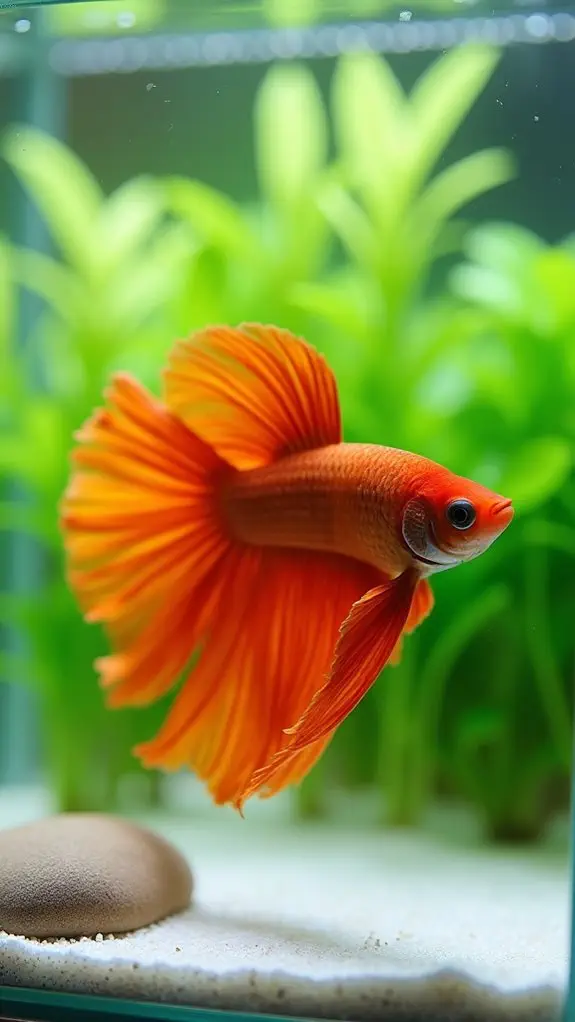
Beginner fish keepers can find success with several low-maintenance species that adapt well to home aquariums. If you're just starting out, you'll want to focus on hardy fish that won't give you a headache with complex care requirements.
White Cloud Minnows and Cherry Barbs are excellent choices, as they're incredibly resilient and won't mind if you're still learning the ropes of fish compatibility and tank decoration. These fish thrive in diverse tank environments, and they often enjoy temperatures in the ideal range of 74-82°F. A larger tank size will help maintain stable water conditions and reduce stress on your fish.
When you're selecting your first fish, consider peaceful community species like Mollies and Platys. They'll get along swimmingly with other tank mates, and they're not picky eaters either!
These easy-going fish will happily munch on standard flake food, making feeding time a breeze. You'll also want to look into Guppies and Harlequin Rasboras, which are perfect for beginners because they adapt to various water conditions without throwing a fit.
Just remember, while these fish are hardy, they still appreciate a well-maintained tank with appropriate hiding spots and plants. Think of them as low-maintenance roommates – they're easy to live with but still need their basic needs met!
Basic Tank Setup Requirements
A successful aquarium's foundation lies in its basic setup requirements. When you're starting your fish-keeping journey, proper tank placement is essential – you'll want to find a stable spot away from direct sunlight, heaters, and air conditioners that could affect your water temperature. The ideal water temperature range is 22-27°C for tropical fish. It's also important to ensure the selected surface can support the weight of your aquarium, as water weighs about 8 pounds per gallon.
Remember, fish aren't fans of sudden temperature changes, just like how you wouldn't want your thermostat going crazy!
Your next big decision involves substrate selection – those small, smooth, dark-colored gravels or aquarium sand that'll make your fish feel right at home. Using a quality water conditioner to remove chlorine and heavy metals from tap water is essential before adding any substrate. Additionally, consider that different fish species may prefer specific substrate types to enhance their comfort.
You'll also need some important equipment: a reliable filter for keeping the water clean, appropriate lighting to maintain natural cycles, and a heater with a thermometer to keep temperatures steady.
Don't forget your maintenance toolkit! You'll want a good siphon for water changes, an algae scraper to keep the glass crystal clear, and a quality fishnet for those occasional fish-catching moments.
Before adding any fish, though, you'll need to cycle your tank for a couple of weeks – think of it as letting your aquarium "settle in" to its new home. During this period, beneficial bacteria will start to establish and improve water quality as part of the cycling process.
It's like moving into a new house; everything needs time to find its place!
Water Parameters That Matter
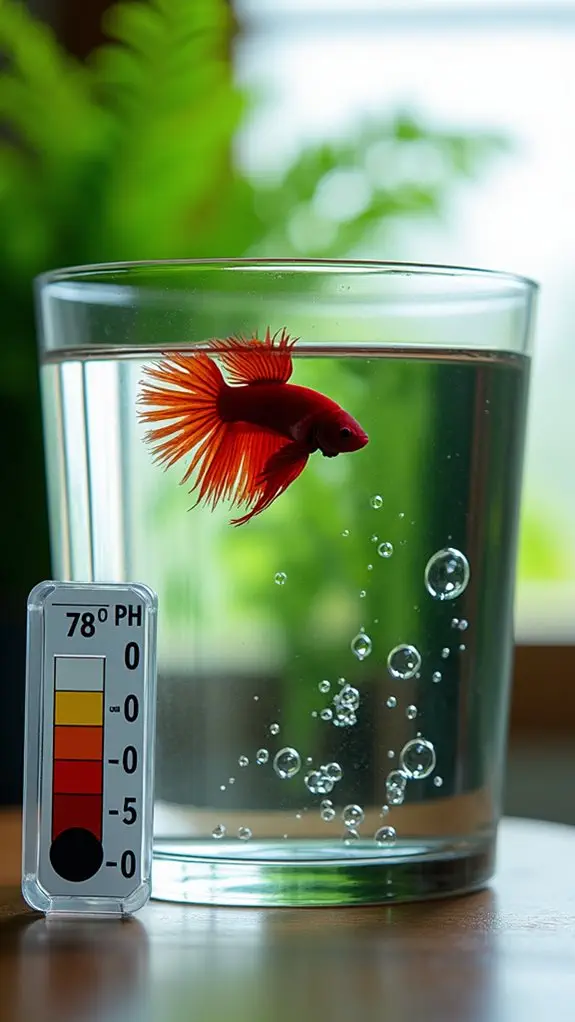
Maintaining proper water parameters stands as the cornerstone of successful fish-keeping. When you're just starting out, you'll need to focus on five key aspects of water quality: temperature, pH, ammonia, nitrites, and nitrates. Think of these as your fish's essential signs – they'll tell you if your underwater friends are living in a healthy environment.
For beginners, you'll want to keep things simple by aiming for neutral pH levels between 6.8-7.2 and temperatures around 72-82°F, which works well for most common freshwater fish. The golden rule? Your ammonia should always be at zero – no exceptions! Regular water changes help maintain these ideal conditions. Nitrifying bacteria are essential for breaking down harmful waste products and promoting beneficial bacteria growth.
Regular parameter testing is imperative, and you'll need to check these values at least once a week.
Don't worry if this sounds overwhelming at first – we've all been there! Start with a basic test kit and keep a log of your readings. It's like being a detective for your fish tank, and you'll soon get the hang of it.
Best Fish for Beginners
Once you've got your water parameters in check, selecting the right fish species becomes your next exciting step. For beginners, you'll want to focus on hardy, peaceful fish that can forgive the occasional maintenance mishap – we've all been there!
Several species stand out as perfect starter fish, and they're incredibly fun to watch. Tetras, especially Neons, make wonderful first fish because they're small, hardy, and love swimming in groups. Quality filtration is essential for maintaining healthy tetras and other community fish. Additionally, they thrive in schooling environments, which enhances their social behavior and reduces stress.
If you're working with a smaller tank size, Bettas can be an excellent choice – they're stunning to look at and surprisingly resilient, though they'll need their own space due to their solitary nature. A reliable heater helps maintain the stable temperature these tropical fish need.
For fish compatibility in community tanks, you can't go wrong with peaceful Platies or Guppies, which come in beautiful colors and get along swimmingly with most tankmates.
When starting out, remember to stick with just two or three fish until you're comfortable with maintenance routines. Cherry Barbs and Rasboras are particularly forgiving choices that won't outgrow your tank, and they'll help you build confidence as you develop your fishkeeping skills.
Daily Care and Feeding

Taking care of your fish doesn't have to be complicated, but it does require daily attention to keep them healthy and thriving.
You'll need to check on your aquarium equipment daily, making sure filters and aerators are working properly, and keep an eye on water levels to maintain a stable environment. Regular monitoring helps prevent ammonia level spikes in your tank.
When it comes to feeding schedules, you'll want to stick to once-daily feedings. Guppies make great starter fish since they have a tolerant appetite and can eat various food types. It's a common mistake to overfeed fish, but remember that they need 16-24 hours to digest their food properly. Maintaining stable pH levels in the aquarium is also crucial for their digestion and overall health.
While you're feeding them, take time to observe their fish behavior – it's the perfect opportunity to spot any potential health issues early on. You might notice changes in swimming patterns or appetite that could signal problems.
Different fish species have varying dietary needs, so you'll want to match their food type accordingly.
Whether it's flakes, pellets, or the occasional treat of frozen foods, make sure you're using high-quality options.
Don't worry about fancy automatic feeders – manual feeding gives you that valuable observation time with your finned friends, and it's actually better for monitoring their well-being.
Common Mistakes to Avoid
Even though you're excited about your new aquarium, you'll want to watch out for three major pitfalls that can spell trouble for beginner fish keepers.
The most common mistakes include tossing in too much food (your fish don't need a buffet at every meal), skipping those essential water tests that keep your aquatic friends healthy, and rushing to add fish before your tank has properly cycled. Additionally, neglecting to perform regular water changes can lead to poor water quality, which poses significant risks to your fish's health.
If you're patient with the setup process, keep your feeding in check, and stay on top of water quality, you'll create a thriving home for your underwater pets.
Overfeeding Fish
One of the most dangerous mistakes new fish owners make is overfeeding their aquatic pets. Just like how you might regret that extra slice of pizza, your fish can suffer serious consequences from too much food. Overfeeding consequences include poor water quality, bloated fish, and a tank that's constantly dirty.
You'll want to master proper feeding techniques to keep your finned friends healthy. Start by offering only what your fish can eat in 3-5 minutes, and don't worry – they won't starve if you skip a day! It's better to underfeed than overfeed. Regularly monitor your tank conditions, since maintaining stable conditions is crucial for fish health.
Watch for signs that you're giving too much: if there's food settling at the bottom of the tank or if your fish look bloated, it's time to cut back.
Using a high-quality food and sticking to a regular feeding schedule will make a world of difference. If you're prone to forgetting or overdoing it, consider an automatic feeder – it's like having a responsible fish-sitter 24/7.
Ignoring Water Parameters
With pristine water being the foundation of any successful aquarium, monitoring water parameters ranks among the most important responsibilities for fish owners.
You'll need to become familiar with regular water testing and maintain stable parameters to keep your aquatic friends healthy and thriving. Think of it as creating the perfect underwater home – you wouldn't want to live in a polluted environment, and neither do your fish!
Before adding any fish, you'll want to properly cycle your tank, which typically takes about five days. This vital process establishes beneficial bacteria that help maintain water quality.
Don't skip regular testing of ammonia, nitrates, and other essential parameters – it's like giving your tank a regular health check-up. Invest in quality testing kits and equipment, as they're your best tools for preventing problems before they start. Regular testing ensures optimal ammonia and nitrite levels should always be at 0 ppm.
Remember to introduce fish gradually and verify your tank isn't overcrowded. A larger tank actually makes this easier, as it's more forgiving when parameters fluctuate.
Consider using a protein skimmer for saltwater setups, and don't forget to maintain proper salinity levels if you're keeping marine species.
Rushing Tank Setup
Speaking of water parameters, many new aquarists make the mistake of rushing their tank setup, leading to a cascade of preventable problems. One of the biggest errors is skipping proper tank cycling, which is like trying to move into a house before the foundation has dried – it's just asking for trouble!
You'll want to resist the urge to add fish immediately, even though that empty tank might look lonely sitting there. Instead, take time to research fish compatibility and plan your stocking levels carefully.
Think of your tank as a tiny underwater neighborhood – you wouldn't want to cram too many residents into a small space or house natural enemies next door to each other.
Don't fall into the trap of cutting corners on equipment, either. A proper filtration system isn't just a suggestion – it's essential for your fish's survival. Ensure you have the ideal cycling temperature set between 78F and 82F for maximum bacteria growth to help establish a healthy environment.
And while you might hear conflicting advice from various sources, stick to reliable information and take your time.
Essential Equipment Checklist
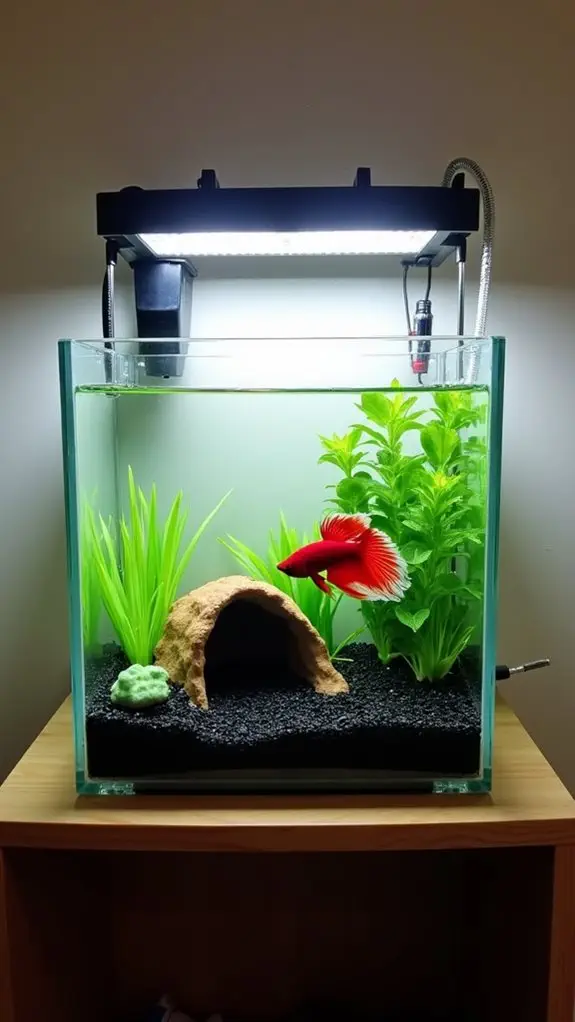
Before setting up your first aquarium, gathering the right equipment is essential for success. While you might be tempted to skimp on certain items, having the proper setup from the start will save you headaches later and reduce the need for equipment upgrades down the road.
Start with the basics: you'll need an appropriately sized tank (20 gallons is ideal for beginners), a sturdy stand, and reliable filtration system. Don't forget the heater and thermometer – your fish will thank you for maintaining consistent temperatures!
For water management, you'll want a siphon, water conditioner, and a dedicated bucket for water changes. These maintenance tools will become your best friends during weekly cleanings. Establishing beneficial bacteria through a cycling process when setting up your tank will also contribute to a healthier environment for your fish.
The fun part comes with choosing substrate and decorations, but don't overlook practical items like a tank lid to prevent escape artists from jumping ship!
You'll also need a fish net, algae scraper, and water test kit to keep your aquatic paradise healthy. Think of these tools as your fish-keeping Swiss Army knife – they mightn't be exciting purchases, but they're absolutely vital for success.
Tank Maintenance Schedule
You'll find that daily tank maintenance is your most important task as a fish keeper, since it helps you spot potential problems before they become serious issues.
A consistent weekly cleaning routine will keep your aquarium healthy and your fish happy, making it much easier to maintain in the long run.
While it might seem like a lot of work at first, you'll develop a natural rhythm that'll make these tasks feel as routine as feeding your pet dog or cat.
Daily Tasks Matter Most
When it comes to keeping fish, daily maintenance tasks form the backbone of successful aquarium care. You'll find that establishing consistent daily routines isn't just helpful – it's essential for keeping your aquatic friends healthy and happy.
Your daily checklist should include monitoring water temperature, checking equipment functionality, and observing your fish's feeding habits.
Think of yourself as your fish's personal health inspector. You'll want to take a few minutes each day to watch your fish during feeding time, making sure they're active and eating normally.
Don't worry about overcomplicating things – a simple once-a-day feeding schedule works perfectly for most fish species. They actually need 16-24 hours to digest their food properly!
Keep your maintenance tools within easy reach, and you'll find these daily tasks become second nature. A quick visual inspection of your tank each day can catch potential problems before they become serious.
Listen for any unusual equipment noise, check water levels, and keep an eye out for excessive algae growth. Remember, it's much easier to prevent problems than to fix them later!
Weekly Cleaning Routine Essential
While daily checks keep your aquarium running smoothly, a consistent weekly cleaning schedule forms the foundation of proper fish care. You'll want to set aside about an hour each week for essential maintenance tasks that'll keep your finned friends healthy and happy.
Your weekly cleaning frequency should include removing 15-20% of the tank's water using a gravel vacuum – it's like giving your aquarium a mini spa treatment! As you're vacuuming, you'll remove debris from the substrate and around decorations, which helps maintain ideal water quality.
Don't forget to replace the removed water with fresh, dechlorinated tap water at a similar temperature.
During your weekly routine, you'll also want to tackle any algae buildup on the glass and decorations using a clean cloth or scrubber. It's amazing how quickly those little green patches can appear!
Make sure to check your filter's performance too – a well-functioning filter is your tank's best friend. By staying consistent with these weekly tasks, you're creating a stable, healthy environment where even the simplest fish can thrive without any fuss.
Frequently Asked Questions
How Long Can Beginner Fish Survive if I Forget to Feed Them?
While your fish can survive up to two weeks without food, don't skip feeding. For ideal survival tips, you'll want to feed them regularly or use an automatic feeder when you're away.
Can I Keep Multiple Male Bettas Together in a Large Tank?
You shouldn't keep multiple male bettas together, regardless of tank size. Their aggressive territorial behavior will lead to stress and fighting. Even in large tanks, they'll attack each other. Keep males in separate tanks.
What Happens if My Power Goes Out During Winter?
During a winter power outage, you'll need to insulate your tank with blankets to retain heat and use battery-operated air pumps for oxygen. Don't feed your fish, as this'll help improve their survival chances.
Do Easy-Care Fish Recognize Their Owners and Show Affection?
Yes, your fish can develop recognition and owner bonding through regular interaction. You'll notice them swimming closer when you approach, responding to your presence, and showing excitement during feeding times.
Should I Add Medicine to My Tank as a Preventive Measure?
You shouldn't add preventive treatments unless quarantining new fish. Focus on regular tank maintenance instead. Only use medications when you spot specific symptoms, as unnecessary medicine can harm your fish and disrupt beneficial bacteria.
Final Thoughts
You'll find that starting your aquarium journey doesn't have to be complicated or overwhelming. By choosing beginner-friendly fish like bettas, guppies, or tetras, maintaining proper water conditions, and following a simple care routine, you're setting yourself up for success. Remember, it's better to start small and do it right than to plunge in too deep. With these basics under your belt, you're ready to create your own underwater paradise.

